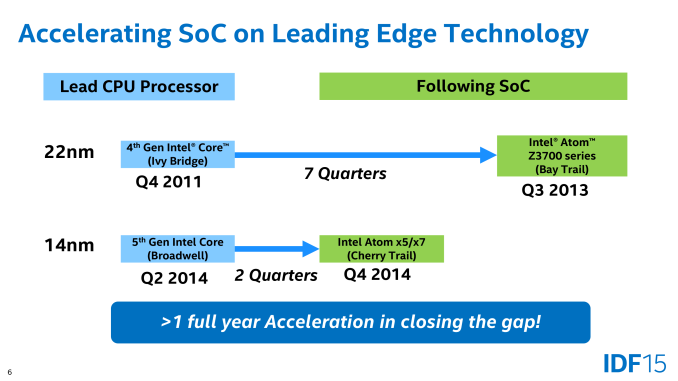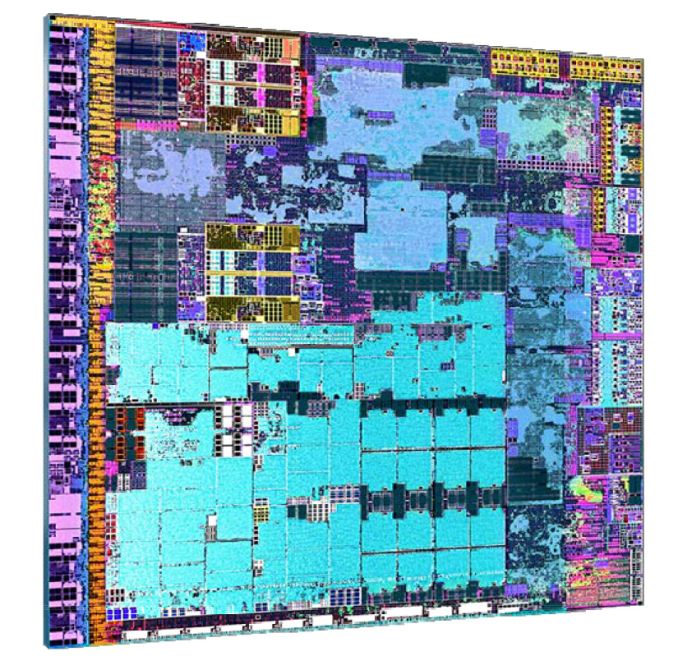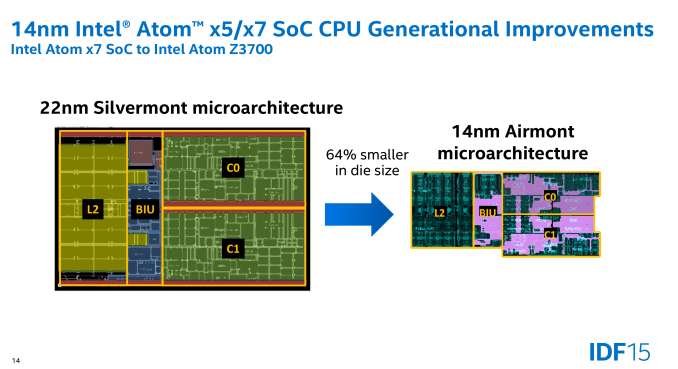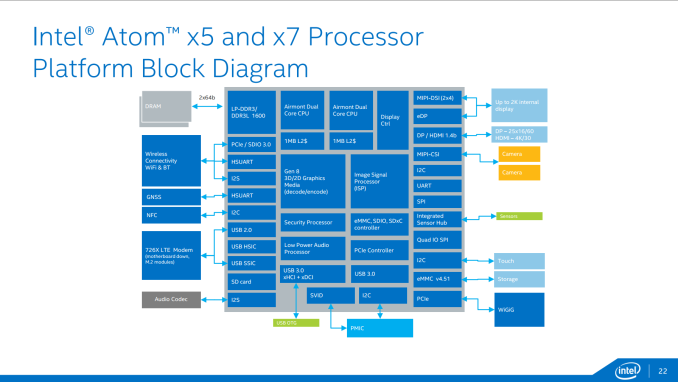The Surface 3 Review
by Brett Howse on May 4, 2015 9:00 AM ESTPowering the Surface 3: Intel’s Atom x7 System on a Chip
I still remember when back in 2011 Intel announced that they were finally going to stop treating Atom as a second class citizen at the manufacturing level, and bring it in line with the company’s mainstream Core processors. After having drawn out the 45nm and 32nm Atoms for too long, and suffering in the marketplace versus ARM as a result – Intel realized that to combat the growing threat of ARM they would need to treat the mobile market more seriously, and they would need to commit their sizable manufacturing advantage to the field to do this.
Now even Intel can’t turn on a dime – processors design begins half a decade in advance these days – so what have seen is a gradual ramping up towards this point. Silvermont, Intel’s first 22nm Atom, would introduce a more modern and better performing out-of-order architecture for Atom, meanwhile Intel would catch up on the manufacturing side by not producing 2 generations of Atoms on the 22nm node. Instead Silvermont would be the only 22nm Atom, and was to be followed by 14nm Airmont roughly a year later.
With Intel’s initial 14nm problems that year later ended up being a bit longer than a year, but in 2015 we’re finally there, and the change is remarkable. Only one generation ago, Intel launched their 22nm process as they always do, with desktop and high-performance laptop processors first. Now with 14nm the tables have been turned; Atom didn’t get first-dibs on 14nm – that went to Core M – but Airmont is still going to beat Intel’s desktop and high-performance Broadwell SKUs to the retail market. In one generation Intel has gone from favoring the desktop to favoring mobile, that’s how serious Intel has become.
That brings us to Surface 3, and the SoC powering it: Cherry Trail. The successor to the Silvermont-based Bay Trail that has powered so many x86 tablets in the last year, Cherry Trail is a distinct tick in Intel's tick-tock cadence. What this means is that Intel has largely retained the same architecture as in Bay Trail, investing in a fairly small number of updates, looking to take advantage of the power consumption and die size (cost) benefits of 14nm. To that end Intel has not even bothered to announce any major architectural changes for Airmont, and while there will likely be a few tweaks made to the CPU to make it work more efficiently on 14 nm, we will have to wait for Goldmont for the next big Atom architecture.
Cherry Trail itself is a fairly small chip. While Intel hasn’t released an official die size for it (no more than they did Bay Trail), from various IDF presentations they have released official numbers for the complete package, and decent photos as well. As a result we can take a decent stab at die sizes, and from Intel’s photos we’d estimate that the die size is around 83mm2. Unfortunately we don’t have anything quite comparable to Bay Trail, though we believe it to be a good bit smaller than Intel’s previous generation tablet SoC. At 83mm2 this would put the die size at quite a bit smaller than Apple’s A8X tablet SoC, and actually is just a hair smaller than the A8 phone SoC’s 89mm2.
Diving a bit deeper, Intel has also released some size data for individual Silvermont/Airmont CPU modules. The dual core modules, which contain the 2 CPU cores along with L2 cache and appropriate glue, have shrunk significantly from Silvermont to Airmont. Overall the Airmont CPU module is 64% smaller than the Silvermont module. And to be clear that does not mean Airmont is 64% of the size of Silvermont, that means that Airmont has been reduced by 64%; relative to Silvermont it is only 36% of the die size. Intel has achieved a better scaling factor than 22nm to 14nm alone, indicating that they have almost certainly enacted further optimizations to bring down the die size as an architectural level.
Moving on to the architecture of Cherry Trail, each Airmont core is a two-wide instruction decode with out of order execution. The L1 cache is 32 KB 8-way associative for instructions, and 24 KB 6-way associative data cache. Level 2 cache is 16-way associative with 1 MB of cache shared between two cores. There will be either two or four core versions available, which means that each SoC will have between 1 and 2 MB of L2 cache depending on the number of cores. There is no L3 cache on Atom.
The System on a Chip (SoC) has support for LP-DDR3 or DDR3L 1600 in dual-channel configuration, and has the blocks needed for PCIe 3.0, USB 2.0, USB 3.0, and support for up to three displays with eDP, DP, and HDMI 1.4b. The built in storage support is eMMC v4.5.1, which is typical for a tablet class processor.
Here is a Block Diagram of the SoC.
The one truely major change to the SoC is the inclusion of Intel's Gen 8 Graphics. Bay Trail used Gen 7 Graphics from Ivy Bridge, and Bay Trail only had 4 Execution Units (EUs) available. Cherry Trail ramps that up significantly, with the latest Gen 8 Graphics from Broadwell now onboard, bringing forward Intel's GPU enhancements over the last two half generations, not to mention the compute enhancements as well.
In terms of execution hardware the x7-8700 model has 16 EUs available, indicating that Intel has spent a significant amount of their die size savings from the 14nm process on graphics resources. Gen 8 has eight EUs per sub-slice but a minimum of three sub-slices in the design, and therefore in order to improve SoC yields the thread scheduler will dynamically allocate the right amount of cores per-subslice to total 16. For comparison, Intel's Broadwell line of Core processors have a minimum of 23 (but most have 24) EUs available, and a maximum of 48, so with Cherry Trail Intel has closed the top-to-top gap in execution resources between Core and Atom to just 3-1.
In Intel’s datasheets, the Atom GPU is labeled as Gen8-LP to designate that this is a low power model being used in a tablet. The base frequency for this GPU is 200 MHz, with a boost of 600 MHz.
In addition to the GPU update, the ISP and hardware decode capabilities get a bump as well. There is full hardware acceleration for decode of H.263, MPEG4, H.264, H.265 (HEVC), VP8, VP9, MVC, MPEG2, VC1, and JPEG, as well as hardware encode for H.264, H.263, VP8, MVC, and JPEG. This marks the first Intel product to ship with the company's full, fixed-function HEVC decoder, making Atom the company's most advanced media processor, at least for this short moment.
The overall SoC is 17mm x 17mm, and the Z-height is 0.937mm, so it is quite a bit smaller than Core M’s 30mm x 16.5mm x 1.05mm package. Intel is not listing a Thermal Design Power for the Atom chip, but is instead listing it as a Scenario Design Power of 2 watts. The CPU base frequency is 1.6 GHz with a turbo frequency of 2.4 GHz, and there is also support for a Low Frequency Mode of just 480 MHz for extra power savings when needed.
| Atom x7-8700 | Atom Z3785 | |
| Architecture | Cherry Trail (Airmont) | Bay Trail (Silvermont) |
| Cores / Threads | 4 / 4 | 4 / 4 |
| Base Frequency (MHz) | 1.6GHz | 1.5GHz |
| Turbo / Burst (MHz) | 2.4GHz | 2.4GHz |
| L2 Cache | 2 MB | 2 MB |
| SDP | 2 W | 2.2 W |
| GPU Architecture | Gen 8 | Gen 7 |
| GPU Execution Units | 16 | 4 |
| GPU Frequency / MHz | 200-600MHz | 313-833Mhz |
| DRAM | LPDDR3-1600 | LPDDR3-1333 |
So what we really have here is a massaged Bay Trail class chip, but the 14 nm process should allow for a higher period of sustained turbo frequencies to help out with performance. It will be interesting to see what Intel does with Goldmont, and if they will add things like hyper-threading or not, but that discussion is for another time.
















265 Comments
View All Comments
meacupla - Tuesday, May 5, 2015 - link
Proprietary connectors only suck when they are easy to break and hard to replace.That said, micro USB connectors also suck on these devices, because they're also easy to break and hard to replace.
The magnetic reverseable connector on previous surface devices was perfectly fine. They were hard to break and easy to replace. Basically, the side that broke most often was either the cable or brick, which is much cheaper to fix or replace compared to the device itself.
ddawg609 - Monday, May 4, 2015 - link
Will it upgrade to Windows10 when it is released?BlueBomberTurbo - Monday, May 4, 2015 - link
Yup, everything that uses Windows 7 through 8.1 can be upgraded to Windows 10 for free for the first year of release.mva5580 - Monday, May 4, 2015 - link
As it seems with most devices these days, my main concern is with battery life.What I really want it to be is an iPad replacement that also happens to be a full PC. I'm fine with the price point (an 128gb iPad Air 2 without a case/keyboard is $700,) I'm fine with the performance (I will play games on it, but stuff that it can handle. SimCity 3000, Baldurs Gate, Out of the Park Baseball, stuff like that,) and the form factor is small enough to feel like a tablet but big enough to be able to do most "full" PC things on it.
It just seems like whenever I look at devices anymore, I'm disappointed in the battery life. So I guess either my expectations are too high, device makers don't care as much about battery life and skimp on it, or maybe a little of both. If this thing could manage the battery life of an iPad Air 2, it would dare I say, be about as "perfect" of a device as I could find for what I want to do with it. For many years to come at least when things this size can run newer, more advanced games.
I have the bundle pre-ordered from Costco that is the 4gb/128gb/Pen/Keyboard combo for $700, and I'm very much looking forward to trying it out. If the battery life isn't a disappointment, I imagine I will love it.
jjj - Monday, May 4, 2015 - link
This is a bulky and very heavy (622 g) mid range tablet and they want 500$ for it.Plus 129 $ for crappy keyboard.And it runs Windows, M$ will never get tablet apps going before tabs are dead. A crippled tablet and a crippled netbook merged into something nobody needs. Some might think they need it but that's only because they don't know any better and you are not helping them.
How hard you try to sugarcoat the pref is also rather hilarious. In GPU you go as far as flooding the reader with synthetic benchmarks (decades of PC benchmarking improvements down the drain) just to hide the single gaming perf numbers at the end.
I thought that after Anand left , the site is regaining some of it's lost objectivity but i guess you are still full steam ahead when it comes to "supporting" certain industry players.
Who payed for that trip to M$'s event last week?
mva5580 - Monday, May 4, 2015 - link
Yes, and you don't sound biased in any way whatsoever. "Bulky and very heavy" in comparison to what, exactly.You're choosing to classify it as a "tablet," can you give an example of a tablet with a similar form factor that is smaller, lighter, and cheaper that runs full Windows?
jjj - Tuesday, May 5, 2015 - link
Bulky and very heavy in compared to the vast majority of tablets. Do the math if you want for screen area per volume.How exactly is running Windows on 64GB of NAND and 2GB of RAM an advantage? If you are gonna just do Office and web browsing then you certainly don't need Windows. If yo want more, then you need more than this.As for the AR, it doesn't matter much and it's actually M$ trying to copy Apple and going just slightly different to not be called a clone. Pricing wise you can do 2x better.
damianrobertjones - Wednesday, May 6, 2015 - link
Ummm... Windows Tablets have been around for a long, long, LONG time. Archos 9, UMPCs, Mids, plus many, many more types.Geodude074 - Saturday, May 9, 2015 - link
Asus T100 Chi vs Surface 3- $450 for tablet/keyboard combo vs $630 for tablet/keyboard combo.
- 1.3 lbs vs 1.4 lbs.
- 1920x1080 vs 1920 x 1280.
- Same 2 GB RAM.
- Same 64 GB storage.
- Same full Windows.
- Z3775 vs Z8700 (the only advantage Surface 3 has).
Is it worth spending ~$200+ for the Atom x7? In my opinion, no not really.
devione - Monday, May 4, 2015 - link
Jesus Christ. I stopped reading at "bulky and heavy".If you find 622g bulky and heavy, you really need to get your life sorted out.